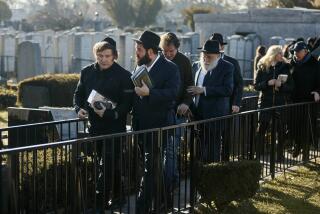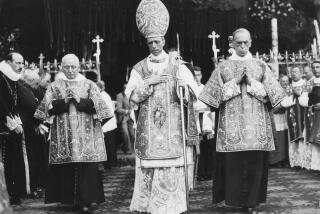Secret Files Yield Data on Nazi Mengele
Argentina’s secret government files on Nazi war criminals, released for the first time to the Simon Wiesenthal Center in Los Angeles, reveal that the West German and Argentine governments knew as early as 1956 that notorious Nazi physician Josef Mengele had fled to Argentina but did nothing to apprehend him.
The documents provide the first official confirmation of what many Jewish groups and Nazi-hunters have suspected for years: that Mengele, nicknamed the “Angel of Death” for the ghastly experiments he performed on prisoners at the Auschwitz concentration camp in southern Poland, lived for years in Argentina without fear of retribution.
The files show that Mengele, who fled to Argentina under an assumed name in 1949, applied for an Argentine identification card under his real name in 1956 and requested a copy of his birth certificate from the West German Embassy the same year, Wiesenthal scholars said. He is believed to have died in a swimming accident in Brazil in 1979, although there is some dispute about the identity of the remains.
The new information prompted calls by Wiesenthal scholars for public access to secret government files in other South American countries as well as the Vatican. For decades the Vatican has been accused of assisting Nazi war criminals to flee to South America in the late 1940s.
“What we are asking for is that the record now be made clear,” said Rabbi Marvin Hier, dean of the center, which received copies of the Argentine files last week. “It has been (nearly) 50 years. Communism has collapsed. Surely there is no reason to keep secret files.”
In a letter last week to Vatican Secretary of State Cardinal Angelo Sodano, Hier insisted it is “time for disclosure” and called upon the Holy See to follow the lead of “most democratic countries” by opening files dealing with the Nazi era. A spokesman for the Apostolic Nunciature, the Vatican Embassy in Washington, declined comment Monday.
Mengele, according to concentration camp survivors’ accounts, often met trains filled with prisoners--the vast majority of them Jews--in his SS uniform as the cars unloaded at Auschwitz. With a flick of his finger, he indicated who would live and who would die. He often saved twins for his own purposes, to be used in grisly genetic engineering experiments in his quest to produce a super Aryan race.
Argentine President Carlos Saul Menem signed an executive decree last week that opened the secret files on Nazi war criminals who fled to his country after the collapse of Nazi Germany in 1945. It will take weeks for the government to collect all its files, but about 17 pounds of documents from the Policia Federal, the Argentine national police, were made available to the Wiesenthal center last week.
Wiesenthal scholars have reviewed only a portion of the police files, Hier said, but they have already come up with the names of seven other suspected Nazi war criminals known by Argentine authorities in the late 1960s to be living there. Hier would not release the names, saying his group wants to research their identities, whereabouts and determine if they are alive. The Argentine government, however, made the files public in Buenos Aires on Monday.
“These files show that the Argentina of the postwar period richly deserved (its) reputation as the world’s greatest safe haven for Nazi war criminals and mass murderers,” Hier said at a news conference in the center’s museum of the Holocaust. “If we had these same files at the same time the Argentinians compiled them, all of these mass murderers would have been brought to justice immediately.”
Flanked by poster-size photographs of Mengele, Adolf Eichmann and other Nazis who fled to Argentina, Hier reconstructed Mengele’s 10-year stay in Argentina, referring to a wad of photocopied Policia Federal documents stuffed in a green folder marked “Jose F. Menguele.” A handwritten note in Spanish, dated Sept. 7, 1971, said that 20 of the 162 documents in the Mengele file had been expunged, but no explanation was given. Argentine officials had warned that many files are incomplete.
Wiesenthal scholars said they were not surprised that some files were “cleaned” in the past by government agencies, particularly because files on well-documented Nazi war criminals such as Eichmann are missing in their entirety.
Eichmann, regarded as the architect of Hitler’s “Final Solution” to exterminate Jews, fled to Argentina in 1946, where he was abducted by Israeli intelligence agents 14 years later. Convicted of crimes against humanity, Eichmann was hanged in 1962.
Even with the missing pieces, the Argentine documents reveal that Mengele fled to Argentina in 1949 with a Red Cross passport--commonly obtained for international travel in the postwar years by so-called stateless individuals--under the pseudonym Gregor Helmut. In 1956, however, the files show that Mengele applied for an Argentine identification card under his own name and requested a copy of his birth certificate from the West German Embassy, Hier said.
The embassy alerted the West German government in Bonn, which in turn notified the Argentine government, Hier said the documents reveal.
“Mengele’s identity and address was known by two governments,” Hier said, “but neither of them had any interest in pursuing him.”
Spokesmen for the German and Argentine embassies in Washington declined comment Monday.
In 1957, Mengele was allowed to travel to Chile under his real name, and in February, 1959, he sought permission to travel to West Germany, again using his real name, Hier said. Later that year, Mengele fled to Paraguay, just months before Eichmann was kidnaped by the Israelis and the West German government issued a warrant for his arrest in Argentina, Hier said.
“If the documents reveal anything that is clear, it is that Mengele was absolutely certain, until 1959, that nobody is interested in him and he can live freely,” Hier said. “(His wife) Martha Mengele had her telephone number listed in the telephone directory in Buenos Aires. . . . And it is clear that in 1959 somebody tipped Mengele off that they were about to issue an arrest warrant.”
Mengele was never arrested or apprehended, apparently moving to several South American countries before settling in Brazil, where he lived in the Sao Paulo area for 25 years under an assumed name until his death in 1979.
Rabbi Abraham Cooper, Wiesenthal associate dean, described the information gleaned from the Argentine files about Mengele as the “tip of the iceberg.” Additional files from the Argentine Foreign Ministry and Central Bank are expected to shed light on claims by a former Nazi officer that he had been asked by German bankers to fly $14 million in gold from Nazi Germany to Argentina.
“These revelations are a tremendous blow to the people who want to whitewash the crimes of history,” Cooper said.
More to Read
Sign up for Essential California
The most important California stories and recommendations in your inbox every morning.
You may occasionally receive promotional content from the Los Angeles Times.










